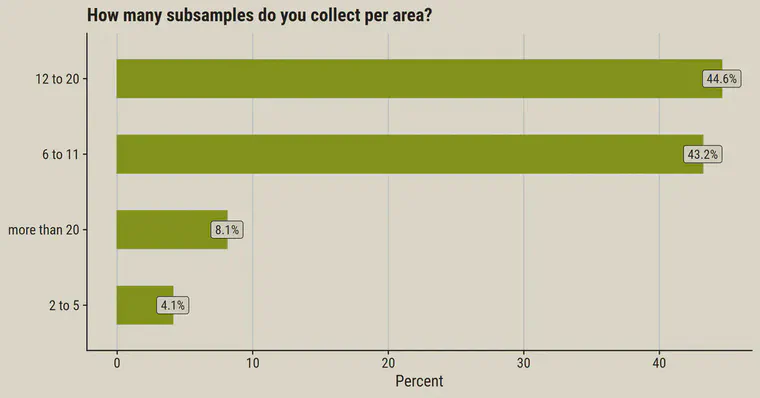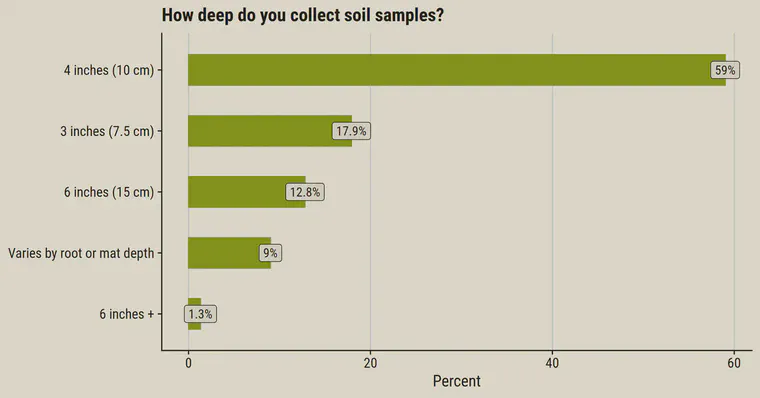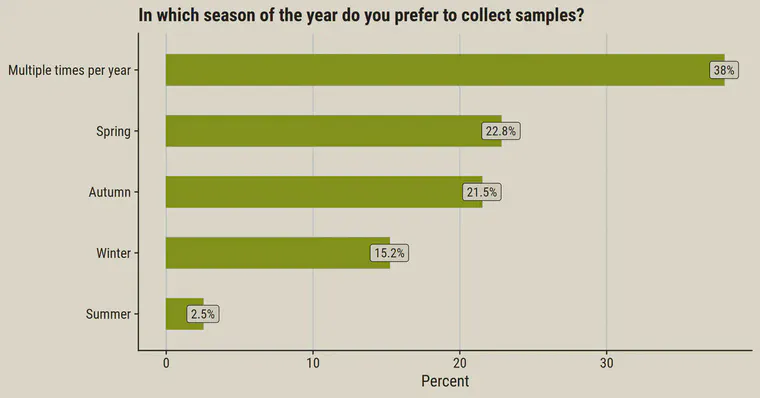Results of the soil sampling procedures survey
Thanks to everyone who completed the soil sampling procedures survey. These are the results from the 79 responses, and I include some commentary about how I would do it.
1. Do you take a composite sample?
The exact wording was “Do you collect subsamples and combine (composite) them into a larger, representative sample for the area being sampled?”
93.7% responded yes, and 6.3% responded no.
A couple years ago, I started trying single core testing. That is, if I were taking a soil sample from a green, I’d pick a random spot on the green and take a sample from that spot, and only from that spot. There are some practical and theoretical reasons why this method, even though it sounds counterintuitive, might actually work. I’ll write more about this topic sometime. If you are interested, see Composite soil sampling for turfgrass for background information.
My answer right now is I do both. Sometimes I do composite. Some of my clients do composite and some have started doing single core. I’m sanguine about single core sampling being equally effective to composite sampling in practice, more effective in theory, and a heck of a lot easier, and I suppose this will be an occasionally recurring topic until I’m more certain about that.
2. How many subsamples do you collect per area?
That was the follow-up question for those who answered yes to question 1 (those who answered no skipped to question 4).

The standard recommendation is to collect 12 or more, and there are 52.7% of respondents following that recommendation.
When I’ve tested the variability of nutrient content in golf course putting greens, I’ve found that I could get an accurate assessment of nutrient status with about one sample per 2,000 ft2. I think that on greens, at least, the standard recommendation is excessive.
3. Do you take a subsample out of the composite?
The exact question was “After you have combined the subsamples into a composite sample, do you … send all the material to the testing lab? or do you take a sample out of the composite sample, and send that to the testing lab?”
85.1% send it all; 14.9% sample from the composite sample and send that to the lab.
The standard recommendation is to take a sample out of the composited and mixed sample. That’s what I have done when I have taken composite samples. But I prefer to let the lab do the sampling out of my sample, so I would prefer to not have to sample out of my composited sample, if that’s the way I was doing it.
4. Do you cut off, or pinch off, the top of the sample containing grass, or thatch/mat material, before sending to the lab?
54.4% leave it on the sample, and 45.6% remove the top of the sample.
I used to remove the top of the sample. Now I recommend leaving it on. I think it is too arbitrary when cutting or pinching off the top of the sample myself. At the lab, the sample will be processed and passed through a screen, and that treatment will remove any non-soil material. I prefer to let the lab system and machines handle this step, because I expect that to be more repeatable than my own removal.
5. How deep do you collect soil samples?

I usually do 10 cm (4 inches).
I think it makes sense in general to sample to the average depth of the roots over the course of the year. But also one should keep that depth somewhat standard. I don’t think it makes sense to measure at 6 cm this year and then 4 cm next year. When sample depth changes, results can’t be compared without a lot of guessing. Unless there is a good reason not to, I’d use 7.5 or 10 cm for turfgrass.
6. When do you sample?

I recommend autumn in temperate regions without salinity issues and end of rainy season in tropical regions. The reason for this is those are the times of year when nutrient levels in the soil—in turf supplied with reasonable amounts of fertilizer—will be the lowest. For a particular site, I’d try to identify the time of year likely to have the lowest nutrient levels in the soil, and that is when I’d want to sample.
When doing multiple times per year, I usually recommend testing at the time of expected lowest soil nutrient content for a primary sampling, and do some additional samplings at another time of year such as the start of the irrigation season in temperate regions, or the end of the dry season in tropical ones.
7. Do you dry soil samples before sending them to the lab?
78.5% do not dry, and 21.5% do dry.
I dry samples before sending them to the lab. The reason I do this is to stop chemical reactions and biological activity. I want to stop that as soon as possible after the sample has been removed from the soil, rather than waiting for the samples to be dried at the lab. Drying the samples also reduces the shipping weight, which can save costs.